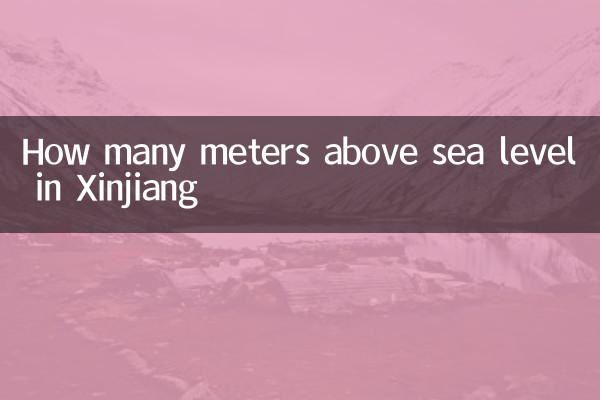How many meters is Xinjiang's altitude? Revealing the geographical height of northwest China
Xinjiang Uygur Autonomous Region is the largest provincial administrative region in China. Its unique geographical environment and diverse topography have attracted countless people's attention. In the past 10 days, discussions on the altitude of Xinjiang have become one of the hot topics. This article will analyze Xinjiang's altitude data in detail for you and attach recent hot content from the entire network.
1. Overall altitude overview of Xinjiang

Xinjiang is located in the northwestern border of China, with a complex and diverse terrain, and the overall geographical pattern is presented in the form of "three mountains and two basins". The following are the altitude data for major areas in Xinjiang:
| area | Average altitude (meters) | Highest point (meter) | Lowest point (meter) |
|---|---|---|---|
| Average across the border | 1,000-1,500 | 8,611 (Jogoli Peak) | -154 (Aiding Lake) |
| Tianshan Mountains | 3,000-5,000 | 7,443 (Tomur Peak) | 1,000 |
| Kunlun Mountains | 4,500-6,000 | 8,611 | 3,000 |
| Junggar Basin | 500-1,000 | 1,500 | 189 |
| Tarim Basin | 800-1,300 | 1,500 | -154 |
2. Altitude of major cities in Xinjiang
Understanding the altitude of major cities in Xinjiang is very helpful for travel planning and health management:
| City | Altitude (meters) | Remark |
|---|---|---|
| Urumqi | 800-1,000 | Capital City |
| Kashgar | 1,280 | Important towns in southern Xinjiang |
| Yining | 662 | Yili River Valley |
| Turpan | 35 | One of the lowest altitude cities in China |
| Wata | 1,372 | The southern edge of the Taklamakan Desert |
3. Recently, hot topics on Xinjiang across the Internet
In the past 10 days, the discussions on Xinjiang across the Internet have mainly focused on the following hot topics:
1.Xinjiang tourism popularity continues to rise: With the arrival of the peak summer tourism season, Xinjiang has become one of the most popular tourist destinations in China. The number of tourists in scenic spots such as Duku Highway, Kanas, and Sailimu Lake hit a record high.
2.Xinjiang's cotton harvest is in sight: Agricultural experts predict that Xinjiang's cotton production is expected to hit a new high this year, with the mechanized picking rate reaching more than 90%.
3.The volume of the China-Europe Express Xinjiang section increases:As an important node of the "Belt and Road", the traffic volume of China-Europe freight trains at Xinjiang ports increased by 25% year-on-year, highlighting Xinjiang's hub position in foreign trade.
4.New energy project construction is accelerating: Large-scale wind power and photovoltaic projects in Hami, Zhundong, Xinjiang have been connected to the grid to generate power, helping the country achieve its "dual carbon" goal.
5.Rich national cultural exchange activities: Various types of ethnic cultural festivals, food festivals and other activities are held in various places to showcase the charm of Xinjiang's diverse cultural heritage.
4. Things to note in high-altitude areas in Xinjiang
For tourists planning to travel to high-altitude areas in Xinjiang (such as the Pamir Plateau), the following things need to be paid attention to:
| Things to note | Detailed description |
|---|---|
| Prevention of altitude sickness | Adapt in advance, avoid strenuous exercise, and replenish hydration |
| Sun protection measures | Xinjiang has strong ultraviolet rays, so high-multiple sunscreen is required |
| Temperature difference response | Xinjiang has a large temperature difference between day and night, so multi-layer clothing is required |
| Driving safety | Mountainous roads are steep, so you need to drive carefully |
| Environmental awareness | Protect fragile plateau ecological environment |
5. Xinjiang's altitude and climate relationship
Xinjiang's altitude differences create diverse climate types:
1.Alpine cold climate: Alpine areas with an altitude of more than 3,000 meters are cold all year round and the snow does not melt.
2.Temperate continental climate: Most areas have this climate, with cold winters and hot summers and few precipitation.
3.Warm temperate arid climate: Low-altitude areas such as the Turpan Basin are hot in summer and are one of the hottest places in China.
Understanding Xinjiang's altitude will not only help travel planning, but also better understand the natural landscape and cultural characteristics of this magical land. Whether you are planning to travel to Xinjiang or simply interested in this land, I hope the information provided in this article will be helpful to you.
With the continuous improvement of Xinjiang's infrastructure and the improvement of tourism services, I believe that more people will be able to personally experience the magnificence and magic of this land in the future. From snow-capped mountains to deserts, from grasslands to lakes, Xinjiang's altitude changes have brought about unparalleled diversity of natural landscapes, which is worth exploring and discovering by everyone.

check the details

check the details